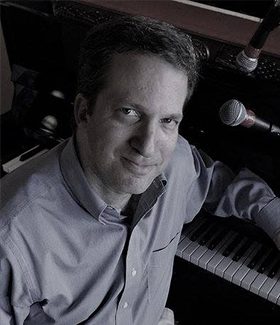Bucktown, MidCoast, Embodied the “Cool, Creative” We Need More Of In The Quad-Cities
Sept. 30, 2016 was one of the best nights of my life.
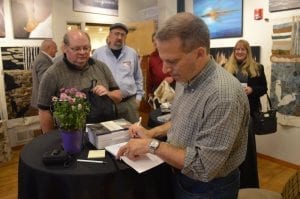
Jonathan Turner signing books at Bucktown.
At the Boho Chic Gallery in downtown Davenport’s Bucktown Center for the Arts, I was surrounded by friends, samples of Front Street beer (including its Bucktown Stout), and copies of my first book, “A Brief History of Bucktown: Davenport’s Infamous District Transformed.”
It was because of this quirky collection of art galleries and studios – which had a brief, busy, vital life from 2005 to this past March – that I was commissioned in August 2014 by The History Press to write the definitive story of the colorful east end of downtown in the first place. The publisher (now part of giant Arcadia Publishing) specializes in these focused neighborhood or city histories and had seen I covered Bucktown Center as an arts journalist.
They knew superficially of the city’s sordid, controversial and profoundly interesting past, helping give Davenport the moniker of “Worst Town in America,” in a 1903 Chicago Record-Herald editorial. (Dan Bush even designed a T-shirt to promote this as a slogan.)
A bustling Bucktown in the late 19th century was known far and wide for its culture, both high and low.
German immigrants created beer gardens, among many other attractions, in the Bucktown neighborhood (east of Brady), establishing the downtown Davenport area as the heart of entertainment for generations. In 1916, the founding of the Tri-City Symphony Orchestra – today’s Quad City Symphony — at the Burtis Opera House (4th and Perry streets) embodied the neighborhood’s reputation for high culture. The numerous saloons and theaters, as well as 42 brothels that flourished within two blocks, lent a bawdy side to the good times.
Over the 18 months it took me to research, conduct interviews, compile old photos and take new ones, and write the 176-page tome, I immersed myself in the sweeping, ever-changing portrait of the district – from the mid-19th century to the present. Like many downtowns across America, the area struggled and declined with the advent of malls, growth of the city to the north and east, and especially as the 1980s farm crisis hit the region hard.
Now, with several revitalized landmarks like the magnificent Hotel Blackhawk and the historic Redstone Building, the community has grown more vibrant as a place to live, work and play. Of course, that was before the wreckage caused by last year’s flood and this year’s coronavirus.
Bucktown has such a rich and fascinating history, including several well-known figures — from Abe Lincoln to Walt Disney to Ronald Reagan to Cary Grant — who had key brushes with the area in their lives. As a longtime writer and musician (who’s lived in the Q-C since ’95), I welcomed the opportunity to showcase the district’s diverse, passionate stories and emphasis on the arts, which have made the area thrive then and now.
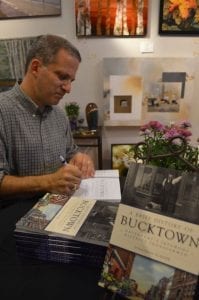
Signing copies of “A Brief History of Bucktown” at the book’s release in 2016.
When the paperback was finally available for signings, I jumped at the chance in fall 2016 to introduce it at the historic four-story Bucktown building, 225 E. 2nd St. (near the Government Bridge), also prominently featured in the book.
Boho Chic was the perfect place, too, since that name seemed to encapsulate the vibe of the new Bucktown – a lovingly rehabbed, lived-in place along the river, with its interior exposed brick, beautiful, eclectic collection of art, and suffused with an electric air the Q-C Chamber likes to name for the region, “cool, creative and connected.”
Since 2020 is the year of closings and cancellations, it seemed apropos that Bucktown was forced to close as well, though it really had nothing to do with Covid-19. Other forces of nature contributed to its downfall. So grab your favorite snack and beverage, and attend the tale of a 110-year-old center of a town that may no longer be wicked, but strains to stay wonderful.
Building on a “Brick” and a legend
Bucktown thrived in part because of the so-called “King of Bucktown”: James “Brick” Munro (1862-1940), who was well-known and loved in Davenport for many years. A former livery driver (who got his nickname for his shock of red hair), Munro operated Brick’s Dance Pavilion and Summer Garden in the area’s heyday at Second and Rock Island streets (Rock Island was renamed Pershing Avenue after a famed World War I general).
Munro also owned seven theaters, a pool hall, livery stable and the area’s first motorized taxi service. He was known nationwide for the saloon, which once employed Al Jolson as a singing waiter and Munro also became known as “the good Samaritan of the underworld,” giving away much of his fortune to children and others in need.
Despite the saloon’s location in Bucktown (named in part for the young bucks that would patronize the bars and brothels), Munro didn’t tolerate prostitutes in his establishment. High-salaried performers from other Davenport stages would stop by the pavilion after their last show, entertaining the crowds.
In his obituary in the Davenport Daily Times, Brick was said to have died in poverty. His pavilion “was one of the most famous spots in Davenport,” the obit noted.
Sixty-five years after Brick’s death, the energy and entertainment at this corner rose again, as a brick building on the former pavilion site — opened in 1910 as as a wholesale grocery business – was rechristened Bucktown Center for the Arts after a $2.4-million renovation.
The building had several uses over the years, including furniture warehousing, and had been empty since 2003, when Peterson Hagge Furniture moved out.
A decade-old nonprofit group – young, scrappy and hungry – named MidCoast Fine Arts (MFA) trained its sights on the building to house art studios and galleries. It also aimed to revitalize an abandoned part of town.
Filling a niche for artists, by artists
MidCoast’s basis began in 1991 as the Cultural Enhancement Organization, installing art in empty storefront windows. CEO was incorporated in 1994. The name was changed to MidCoast Fine Arts in 1996. Dean Schroeder and fellow artists led the charge to help add life to vacant storefront windows in downtown Rock Island, and later downtown Davenport. It billed itself as the only arts organization within a 90-mile radius where beginning artists can show and sell their art while they learn the business of art.
Then, most other places offered only juried shows that beginning artists have trouble entering. The arts also provide fiscal security for the community as endeavors that attract and retain quality employees and employers, according to MidCoast.
Spaces like the Bucktown Center for the Arts and MidCoast galleries in Davenport, Rock Island, and Moline aimed to increase traffic in our metropolitan centers, enhancing the value of our downtowns and fostering arts and culture as an effective urban revitalization tool.
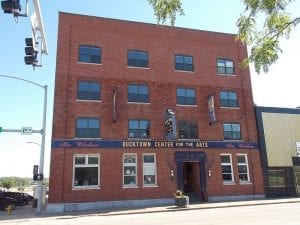 “I and a handful of others started MidCoast to help regional artists,” Schroeder, who served as executive director to 2012, said recently. “There was a lot of attention being paid to performing artists, but there wasn’t the proper exposure needed for visual artists. What we did was find high-profile venues and partner with the people involved, and brought the visual arts to the forefront.”
“I and a handful of others started MidCoast to help regional artists,” Schroeder, who served as executive director to 2012, said recently. “There was a lot of attention being paid to performing artists, but there wasn’t the proper exposure needed for visual artists. What we did was find high-profile venues and partner with the people involved, and brought the visual arts to the forefront.”
“Originally, the group was run by all artists, including its board,” he noted. “But over time, it was perceived best to have more heavily community involvement on the board. I think over time, it began to lose sight of our real purpose. Everything changes, everything evolves. I place no blame, don’t have any hardships.
“It just is what it is. God bless visual artists, it is like herding cats,” Schroeder said.
He partnered with the Development Association of Rock Island, to open a Gallery West, 1629 2nd Ave., Rock Island; with MetroLink to open a gallery at Centre Station, 1200 River Drive, Moline, and the Q-C visitors bureau to open a gallery at the former Mississippi Valley Welcome Center in LeClaire, which closed in 2011.
Creating Bucktown – with studios and galleries on the first two floors of the downtown Davenport building, just down the street from the then-new River Music Experience – also helped serve as a catalyst to develop that end of downtown and boost the awareness of the area’s art scene.
“The number of artists we were able to push to the forefront, that helped not only artists, it helped create, it raised the profile of this community,” Schroeder said. “It looked like a cultural destination, and that is a win-win.”
 “You can have only so many sports venues — that plateaued,” he said. “When you put the arts in the forefront, it becomes a cosmopolitan community.”
“You can have only so many sports venues — that plateaued,” he said. “When you put the arts in the forefront, it becomes a cosmopolitan community.”
“Bucktown specifically was one of the drivers of the east end of downtown,” said Kyle Carter, MidCoast board member and executive director of the Downtown Davenport Partnership. “When it opened, there wasn’t anything else down there. Dean hoped that it would become an economic driver and it was. Far more than a place for the arts, it helped push development in a meaningful way and successful way.”
Its catchy name “certainly celebrated the liveliness that had been in that area,” said Sherry Maurer, MFA executive director since 2015. “It was very colorful.”
MidCoast owned 67 percent of the building, with the rest by owners of condominiums on the upper two floors. There were some offices on the third floor, including the former home of the Midwest Writing Center. “It was an incredible accomplishment,” Maurer said.
“We’ve had hundreds of artists, both amateur and professional, walk through these doors,” MidCoast board president Amy Orr said. “We’ve seen it all – from painters, sculptors and animators to photographers and jewelry makers – and MidCoast has become a better organization because of it.”
The indomitable Pat Bereskin operated her gallery and studio on Bucktown’s first floor from 2013 to 2017, when she moved to a much larger space at 2967 State St., Bettendorf. Along with Bereskin’s art gallery on the first floor, the 8,000-square-foot property houses 212 STEAM Labs, offering science, technology, engineering, arts and math (or STEAM) classes for preschool, elementary and middle school-aged students.
Bereskin loved the collective nature of Bucktown, showcasing a vast variety of artists, which she continues to do in Bettendorf. She called it “that awesome energy with other artists.”
“It’s like lasagna – everybody brings another layer and it tastes better,” she said of Bucktown. “On top of that, we keep each other in checks and balances, evaluating each other’s work. It’s multi-generational and diverse. I think we’re a pretty unique place.”
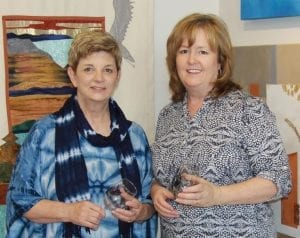
The artists of Boho Chic.
Heidi Brandt, former co-owner of Boho Chic and a real-estate photographer, said: “We all do something different. All of our strengths individually, it’s a nice smorgasbord mix. We have business people, teachers, bankers, retired Arsenal and Deere. We just, all of our talents really meld together. This place, to me, is an arts incubator.”
Many people also want to support local artists, others in their own community, Brandt said. “That’s what I do when I travel. You get such a better feel for the area when you visit those local places. And you’re helping to support people’s livelihoods.”
In 2005, downtown Davenport billed 2nd Street as an arts corridor, bounded by the double “225” – the spectacular $49-million, 115,000-square-foot Figge Art Museum, which opened in August 2005 at 225 W. 2nd St., and Bucktown, which opened in April that year. Second Street also featured the 2004 opening of RME at the restored 1892 Redstone building, along with stalwart Major Art and Hobby Center, and the newer Crafted QC, which includes handmade arts and crafts from many local vendors.
In “A Brief History of Bucktown,” Carter called Bucktown Center “the pioneer in the east end of downtown. Back in 2004, there wasn’t anything over there. It was a ghost town. Now it’s one of the most vibrant corridors that we have.”
“Regardless of Bucktown’s future – failure or success – it has achieved its initial goal, which was to create a home for the artists, and serve as an economic development engine for that chunk of downtown that was just absolutely vacant,” he said.
Special events and changes transform the place
While Bucktown was normally open to the public Wednesdays to Saturdays, it perhaps attracted its biggest crowds for special events, like the annual Venus Envy QC festival that ran from 2005-2014, and the monthly Final Friday celebrations from 6 to 9 p.m. It was at that September ’16 Final Friday where Brandt and then-gallery co-owner Dee Schricker marked 10 years of exhibiting their art at Bucktown. Wine, cheese and crackers were always a great part of Final Friday receptions.
The Venus Envy franchise was founded in St. Louis in 1999 and expanded along the Mississippi River later to Memphis, Tenn., and Baton Rouge, La. In the Q-C, it retained its mission of focusing on the creativity and imagination of women.
Paintings, sculptures, media installations, dramatic readings, music, dance and other types of creative works from women artists within a 200-mile radius were showcased inside and outside Bucktown, to consistently delightful effect.
Before the 2013 event, the VEQC director said: “Venus Envy Quad Cities is one of the most entertaining events of the year. Where else can you go to find music, art, performance, poetry, hula hooping and belly dancing all at one event?”
Then, on the first three floors of Bucktown, festival attendees experienced over 100 art works by more than 40 visual artists (from within a 150-mile radius) including painting, photography, fiber, printmaking, stoneware and collage. Belly dancing, spoken word and hula hooping also will delight all audiences.
Outside, attendees enjoyed five musical groups performing folk, R&B, acoustic rock and indie on the two stages on Pershing Avenue for non-stop music throughout the night.
Sherry Maurer said recently that among her fave Bucktown memories were the December Final Fridays, which featured the Black Hawk College Chorale going around doing Christmas carols and the Wine Walk, where guests could buy a painted wine glass (from a local artist) for $20 and get samples of five wines throughout the building, with other free snacks in the galleries. Part of the proceeds always went to the Greater Mississippi Valley chapter of the National Alliance on Mental Illness (NAMI), which promoted its programs at Bucktown.
“It was really important for NAMI because the money went to them in January and February and gave something to tide over their budget, so they had some starting funds for the year, to raise money,” Maurer said. “Every nonprofit is trying to leverage what they have. They helped us by publicizing the event.”
One year at a Final Friday, she recalled a Sinatra tribute singer, and little kids were dancing as he’s singing away. “That was wonderful,” she said.
After Schroeder retired as executive director, Pamela Crouch (executive director of Living Proof Exhibit) came on as his successor for a couple years, before Maurer joined in 2014, mainly to oversee Bucktown, its artists, rents and building operations.
Maurer worked for the Augustana College art program from fall 1983 to spring 2013, including gallery manager and art museum director. Her first impressions of Bucktown: “It was a really ambitious and an active, grassroots, local arts organization.”
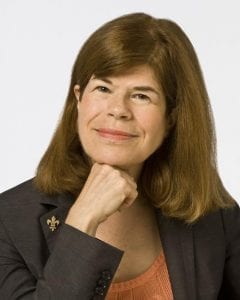
Sherry Maurer
After becoming executive director in 2015, Maurer’s job expanded to recruit and organize the many volunteers for the annual Riverssance Festival of Fine Art at Lindsay Park in Davenport, each September, the nonprofit’s largest fundraiser of the year.
To relieve MidCoast from being a landlord and responsible for Bucktown building maintenance, the group sold its controlling interest in the building in August 2015 to developers Y&J Properties, which specializes in rehabilitation of historic buildings in Davenport. The company owned the upper-floor residential space and planned to redevelop the second and third floors to more residential use within 18 months after the sale, which is still an unmet goal.
Y&J Properties rehabbed more than 200 loft units in downtown, by 2016, including the Peterson Paper building across from Bucktown, and Halligan Coffee Company Lofts at 4th and Iowa streets.
In 2019, Y&J completed the Gordon-Van Tine Commons, a $35-million project at Federal Street and East River Drive. Y&J is a partnership of Joe Erenberger, Manisha Baheti, Tom Piehl and Levi Richie.
A total of 113 market-rate apartments and eight ground-level store fronts were created within two brick buildings that in the early 1900s housed the Gordon-Van Tine Co., a major builder of ready-cut, mail-order homes.
At the time of the 2015 deal at Bucktown, the agreement was that MidCoast would lease the first two floors for 10 years. The company that bought the building was trying to get historic tax credits, and MidCoast used the second floor, but thought they were going to have to move out in 2017. It turned out Y&J didn’t get the tax credits, and MidCoast remained using the first two floors until moving out after March 31, 2020.
Fundraising was always a challenge
Maurer and the board often ran into obstacles in winning grants for MidCoast’s ongoing operations, as opposed to special programs or projects.
“The problem was that, as you get bigger and it gets more expensive and you keep adding things on and on, you have to start tailoring what you’re doing to meet new programming,” she said. “Because grants more and more only wanted to fund new programming, rather than operational costs. As that happened, it became increasingly more difficult. Dean Schroeder deserves great credit for expanding this grassroots arts organization into all corners of the Quad-Cities.”
“Dean did everything he could, in a very creative way, to think about creating a sustainable, fundable model for that building, by having condos on the fourth floor and third floor, office space on the third floor, and individual artists’ suites on the first and second floors,” Maurer said of Bucktown.
While Schroeder said recently he didn’t have much trouble in getting support for his quarter-million dollar annual budget, the grants from Regional Development Authority and Scott County Regional Authority were getting more competitive among area nonprofits, Maurer said.
“It’s hard to compete against food pantries and homeless shelters, as a cultural organization,” she said. “It just became obvious that private funding was going to be essential. By the time I was hired, the building was too much for the organization to support – building maintenance, like tuckpointing the outside or completely re-roofing the building. Those were hurdles the organization was never going to be able to handle.
“The mortgage was actually more than the organization was going to be able to handle,” Maurer added. “Outside funding groups were saying, we can’t fund you because you’ve got this huge mortgage and you can’t concentrate on programming.”
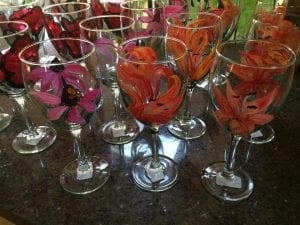
The Wine Walk was a popular event at Bucktown.
In 2019, MFA had a $140,000 annual budget, 75% of which came from grants, and $20,000 to $30,000 from its Riverssance festival.
Corporate and private support was needed, Maurer said. “Grants are unpredictable. You really need someone to come forward and say, hey, I’m going to support this at a quarter of your budget for five years. We didn’t even come close to that.”
“We kept trying to prove the value and distinction of what we were doing, particularly supporting emerging artists, giving them a chance to show their artwork and sell it for the first time,” she said. “And we were supporting established artists, who had studios at home, and wanted a place to show and sell their work.”
In 2017-2018, MidCoast did special fundraising for the project to move the former second-floor MidCoast Galleria to a first-floor Artists’ Market. The $60,000 in renovations were supported by grants from the Hubbell-Waterman Foundation, the RDA and SCRA, as well has a loan from the building owners.
“The lighting makes a huge difference,” Maurer said, noting the 2,200-square-foot first-floor space was vacant more than five years after Small Wonders Photography moved to Rock Island.
“It was expected there would be much more life to that spot. It turned out to be a better spot for the artists’ market,” she said. “It had better lighting; it had street presence, and it actually worked better as a space.
The customer traffic was higher on the first floor, increasing 27 percent from 2017 to 2018.
Gallery manager Tony Seabolt supervised the market representation and sales. About 50 area artists were represented with original works in jewelry, ceramics, drawings, painting in all media, fused and blown glass, mixed media, sculpture, printmaking, photography and fiber works.
“We had this vision; we could bring the flow to the first floor and bring a unified shopping experience to the first floor,” Seabolt (a six-year Bucktown manager) said.
“A lot of times I’d be upstairs and people would go through the building and, for whatever reason, they wouldn’t go upstairs,” he said. “I don’t know how many we didn’t get because of that factor.”
The second-floor space had been split with the left side hosting rotating exhibits every two months and the right showing works from 30 to 35 artists for sale. The artists lease wall and counter space, and MidCoast doesn’t take a commission.
“We couldn’t get that funding because people couldn’t see the different between the Figge Art Museum, Quad City Arts and MidCoast,” Maurer said. “There’s a very distinct difference between what each was doing. Quad City Arts’ main thrust in the world is the Visiting Artist program.”
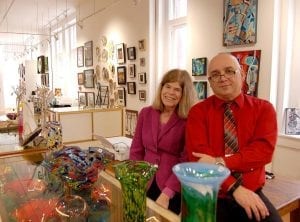
Sherry Maurer and Tony Seabolt at the Artists Market at Bucktown in Davenport.
“They do have gallery spaces, with commission on sales, and the Figge has a gift shop, which includes some local artists, but it’s not intended to be devoted to local,” she said. “There were places of overlap, but from our survey, made it clear people really didn’t understand the distinctions. The financial supporters thought we were a duplication.”
MidCoast was unique in “pretty much artists running the organization for artists,” Maurer said. “We were the only organization in town, totally just devoted to visual artists and physical gallery spaces for them. There are other organizations, like Left Bank Art League, devoted to visual artists, but they took out the commitment to a permanent exhibit space.”
“It came down to, there was some misperception there, what was our niche,” Carter said. “We understood it really well, and thought other arts organizations understood it clearly. The funding out there was so thin for the arts, the amount of money, we weren’t able to stretch it another year.
“I understand, we’ve always been a grassroots organization, from back in the ‘90s, it’s always been a pretty scrappy group,” he said. “The downside of that very bottom-up, grassroots upbringing is, you don’t have that foundational financing in place. We were always playing catch-up. It was a noble effort, but it caught up to us the last couple years.
“All things considered, the organization was around for an extraordinary period of time and did extraordinary work,” Carter said. “I give credit to all people involved. I think it provided a unique place for local artists to display and sell art, that’s not replicated anywhere else.”
“We were so proud to be able to hand off Riverssance to Quad City Arts, and many of the artists who had space in Bucktown were able to find spots somewhere else.”
2019 a year from hell
If you think 2020 has been bad, MidCoast had a devil of a time dealing with 2019, highlighted by a bunch of bitchy moves from Mother Nature.
The polar vortex of winter 2019 kept customers away from galleries, and the spring thaw brought record-level flooding in the Q-C.
When the levee broke April 30, 2019, and created a river on 2nd Street, they expected a month to get Bucktown cleaned out. Water only got into the basement, not the first floor, but debris in the basement hit one of the water pipes and broke it, and there was some first-floor damage. The building was basically cleaned in a month, and lost about $20,000 in supplies in basement.
The city ordered the wiring be redone, and the building owner took another six weeks for that, Maurer said. Bucktown lost rent for two and a half months, in addition to losing supplies.
“There was no grant in the world that was going to cover those kind of losses,” she said. They did some fundraising at restaurants and other places while they were closed, but it was $100 here, $200 there. They re-opened in July, planning Riverssance, last September, but that month it started raining and never quit.
“By the time the third weekend rolled around, nobody was going out because it was raining so heavily,” Maurer said. “We tried to do Saturday, and had pittance of attendance. The artists did have some sales, the big concern was the park grass.”
“With that wet turf and weather forecast of two more inches of rain that night, we said to the artists, if you stay on Sunday, you can’t drive in and get your work. It was decided by consensus that Sunday would be canceled. That was the first time in 32 years that it had been completely canceled, and that was about a $13,000 loss.
“You combine those things, we had some capacity building grants that year (from Iowa Arts Council and Quad City Arts), looking to get active work from the board, we actually raised more than had raised in anybody’s memory in 2019,” she said. “The problem was we lost so much too. It was very sad.”
“We couldn’t get that big, sustainable support source. Without that, it just didn’t look like the organization should continue.”
“We were always in the same position, of not being able to see ahead, of where the money was gonna be in between the grants, and all the grants could go away with there was a disaster,” Maurer said. “Isn’t that telling, because with the Covid-19 situation this spring, those grants that we normally would have applied for, they had to take off the table.”
In March, the RDA canceled its spring grant cycle and instead supported a Quad Cities Community Foundation disaster relief fund and local nonprofits that serve the most vulnerable. The SCRA also changed its cycle to focus on pandemic relief.
“Some granting organizations were shifting from operational funds, to programming, which I understand, but the biggest challenge was, we needed operating,” board president Amy Orr said last December. “By no means was the flood the reason we’re closing. This has nothing to do with the flood. … We’re trying to do what we feel is best for the organization.”
For years, it’s been hand-to-mouth with grants,” Carter said then. “It was barely enough to begin with, but we had the apocalyptic 2019 — dealing with the polar vortex, the flood, our model was already shaky to begin with, and we got rained out at Riverssance.”
The MidCoast board then was in discussions with Quad City Arts, to see if it could take over the Moline gallery space (as it does at the Quad City International Airport), run the Riverssance festival (which has a 10-member volunteer committee), and take on the annual High School Pastel Mural Competition, typically over Memorial Day Weekend, Carter said.
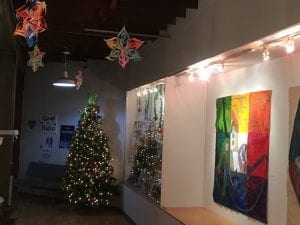
Midcoast hosted a variety of local artists and events. Their last days open were during and just after the holidays last year and into early 2020.
“The gallery spaces, the small studios in Bucktown remain open through March; we’re at peak holiday shopping time,” Orr said in December. “We could have waited after the 1st of the year, but we respect our family too much,” she said. “We wanted to give them plenty of time to prepare and make arrangements…We have artists that have amazing work, who deserve to be looked at and purchased.”
“It’s certainly not an ideal time, in any way, shape or form,” Orr added. “We were in a financial hard spot several years ago, and we had the good fortune to be able to sell our stake in the Bucktown building (in 2015), so we’re no longer property owners.”
Several years ago, MidCoast also considered merging with Q-C Arts, but decided to remain independent, Carter said.
Kevin Maynard, Quad City Arts executive director, said: “Our goal in this whole thing is to keep their programs going. Obviously, we want to lessen the void it’s going to create.”
At last September’s Riverssance, even with the rain, Maurer said the 2019 Harley Award presentation (to Terry Rathje) was inspiring.
“It had been raining all day, the artists were feeling blue, knew Sunday was canceled, we had Streets of Italy pizza,” she recalled. “We gave out awards to artists and it was such a celebration, a realization that despite everything, visual arts persevered. That was a wonderful memory.”
Maurer treasured seeing how Bucktown artists’ work had progressed. “People like Laura Vincent Arnold, growing as an artist. She just started out a year and a half ago, and really blossomed as a painter. That was very rewarding. And interacting with all these artists in one place.”
“We were able to close fairly well. There was a transition,” Maurer said. “We had great sales; December was the second or third best sales month we’d ever had. January and February were great too. The artists were basically, many of them, got great sales for the three-month period.”
Bucktown robbed of a final farewell
The Covid-19 pandemic – which has visited horrific human and economic devastation on the world – also had to take away the Bucktown’s last Final Friday, scheduled for March 27.
“We just missed doing the finale at Bucktown, which we had planned – great music, art, big final reception, with lights all around the bottom of the building,” Maurer said. “By the time we reached the board meeting of March 18th, it was clear that assemblies of over 50 people were not going to be permitted, and we just weren’t gonna be able to do what we wanted to do. Illinois’ stay-at-home was ordered, and it just gave us enough time for artists to come in and get their work, because we had the March 31 date for closing.”
“It’s not the way we wanted to say goodbye,” she said. “By the time everyone realized the Covid-19 thing was gonna be a problem, we really had at least two and a half months for people to come in.”
Bucktown was closed to the public effective March 18, “MidCoast has had an amazing run, and this is not how we wanted to say goodbye to the community and each other,” the organization said on its website. “We want to thank each of you for your contributions to this organization — as a supporter, an artist, a volunteer, a staff member or board member. Without your support and your passion for MidCoast and the arts, none of this would’ve been possible.”
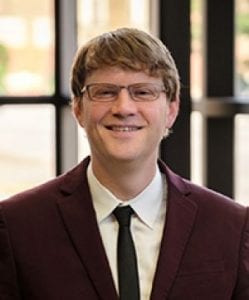
Kyle Carter
“We’re very proud of the history we had. We had tried to hold on longer, but between the flooding and Covid, we ended it at just the right time,” Carter said. “The organization was not going to survive that. I’m glad we had a graceful exit, gave people plenty of time.”
“Bucktown was specifically robbed of its final farewell. That was disappointing, but there was nothing we could do about that,” he said. “We hope that once the dust settles on all the insanity of 2020, we can properly celebrate MidCoast and Bucktown’s history. We do plan to have some kind of official send-off.”
The building owners are still planning commercial on first floor, but renovations are stalled by Covid and the tense racial situation nationwide. “We’re living in a Batman movie; no one knows what’s happening here,” Carter said. “MidCoast accomplished a lot in its many years in the artistic and economic development fronts in the way we intended to. We’d hoped to have a little stronger foundation, to weather the storm.”
What does the future hold?
Some area artists have developed spinoff ideas to display their work elsewhere in Davenport.
Karolyn Williams of Bucktown’s Estate of Grace plans to show her clothing, jewelry and antiques, with some other Bucktown artists at the former SiS International Shop at 108 E. 2nd St., Davenport. The fair-trade store – with goods from around the world – operated there for eight years but closed in late February. The gift shop had been struggling before, but the flood of 2019 did it in.
Williams said this week she’s hoping to open Aug. 1, with at least 15 other of her Bucktown colleagues. “I am very excited about the new gallery space. We all miss the energy that flowed through Bucktown,” she said.
Maurer said some artists looked into opening space at NorthPark Mall, but that was shelved. MidCoast gave away assets, like walls and pedestals, to artists. Azubuike African American Council for the Arts – which was based at Bucktown, will re-establish itself, not necessarily as a gallery, Maurer said. Its Facebook page said that due to Covid-19, it’s moving its programs online.
For several years, Maurer has been teaching art history and art appreciation at Black Hawk College, as well as summer drawing and art appreciation at Scott Community College. She’s also culling a MidCoast history that will be available at the Davenport Public Library Special Collections by December 2021, as well as a census of community visual artists, to be sent to area nonprofits.
This past winter, Tony Seabolt got his first solo exhibit on the first floor of Bucktown through the last Friday of January. Seabolt prefers painting abstract art because of the freedom and flexibility it offers.
“It’s exactly like jazz,” he said. “There is feeling in it. I conjure rhythm, emotion, making subconscious arrangements and patterns … I paint music for the eyes.”
Art enables him to have power and control, in times where he often feels neither.
“I think the dynamic that’s affecting us, I don’t think the public realizes how their support works with us,” Seabolt said. “I don’t know if they realize the importance of art in the community. The artists here, this has so many different bearings — it’s mostly not their major life’s work. The art they make, it relieves their stresses. It keeps them occupied — some of the artists we have here are older, and their love for art gives them a reason to wake up every morning. This is a family; these artists are a family. They all know each other, support each other and inspire each other.
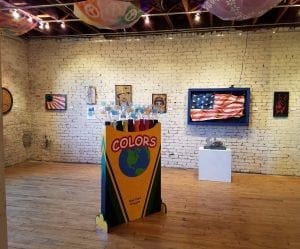
Alan Campbell’s exhibit at Bucktown in 2017.
That’s the sad part of closing, he said.
“You’re surrounded by things you love, made by people you love,” he said. “I can’t tell you the stories I’ve had, people I’ve met from all over the world — Austria, Japan, Germany. You never know who you’re going to meet. I feel invested in the future of these artists.”
Before the March closing, Seabolt got a new job as community arts director at Quad City Arts, but he left that effective May 1, saying it wasn’t a good fit and was too stressful. He’s not sure what the future holds, preferring to get a more mindless job in retail. Maynard from Q-C Arts said he’s keeping the director job open for now.
Carolyn Krueger – who ran the ARTery in the same Rock Island building as MidCoast Gallery West, from 2009-2020 – and Jodean Rousey Meleski, a program director who was liaison with the Riverssance committee, were the other part-time MidCoast employees.
On April 1, as Krueger closed the ARTery, Meleski posted on Facebook:
“Such a great run. You were a fantastic gallery owner! Truly inspiring. On to bigger and better things! It makes my heart wrench seeing it as an empty storefront but how apropos that it ends as it began. My first gig with MidCoast was installing work in empty storefront windows of downtown Davenport buildings. It was dark empty voids that showcased brilliant artwork.”
“It was a vision brought to fruition by Dean Schroeder. I met so many great artists and have so many stories! Kudos to all that made it happen and cheers to the next innovators that brighten the empty windows.”
Alan Campbell, a Davenport artist who exhibited at Bucktown, and continues to volunteer with Riverssance, said:

Alan Campbell
“When I think of Bucktown, two things come immediately to mind. First, it provided me such a tremendous opportunity to learn and explore. At the core of it, I think that’s what Bucktown was all about, giving new artists a place to grow their talents. I’d been a photographer for years and that was what I first displayed when I began exhibiting at Bucktown. But I wanted to do other things, to find new paths and create art that had nothing to do with photography.
“Without Bucktown, I don’t think that would have happened for me,” he said. “I was able to display my artwork without judgment. I learned so very much. It was really like taking a class, both in creating art as well as learning how to present it to the public. Looking back, I cringe thinking about some of the pieces I put out there.
“But as my better work began to sell, it gave me the confidence to continue and believe that I can do it. I know it provided that same influence for countless other artists who are out in the community today doing wonderful things thanks to the start they received at Bucktown,” Campbell said. “More than anything else, more than the special arts events, the Final Fridays, and so much more that will be missed, that nurturing incubator of art is the greatest loss. Second, on an even more personal level, the Bucktown artists, along with Sherry and Tony, were family.
“I so much looked forward to those Final Fridays because they were our monthly family get-togethers. Every artist who displayed their work in that building, whether in the artists gallery or their personal shops, were family, supporting and caring for each other,” he said. “Certainly, we keep in touch via social media but years from now when I look back at my time with Bucktown, it will be my family I miss the most.”
And certainly, we need family and art and support and creativity and kindness today, more than ever. If making art helps you de-stress, we should have plenty of masterpieces of coming out of this endless period of quarantine and deep unrest.
Thank you Bucktown and MidCoast, for helping the Q-C vie for “The Best Town in America.”


